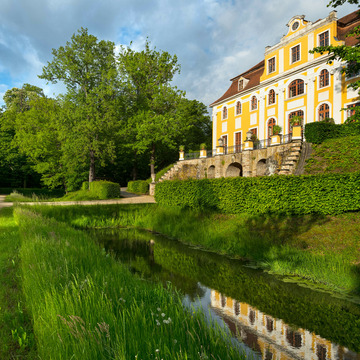GERMAN-POLISH WORLD HERITAGE SITE
MUSKAU PARK / MUSKAUER PARK / PARK MUŻAKOWSKI
CONSERVATION WITHOUT BORDERS
Muskau Park has a special feature that makes it unique the world over: thanks to its location on the River Neisse, the landscape garden straddles the territory of two countries, namely Germany and Poland. For more than two decades now, cross-border cooperation has been a daily occurrence here – with outstanding examples to show for the cooperation's success. Together, the two countries have succeeded in reuniting the parts of the park that were divided in 1945 and at the same time made an important contribution to relations between the two nations. Destroyed bridges have been rebuilt, views obscured by undergrowth freed up and lost pathways retraced. Muskau Park was awarded UNESCO World Heritage status in 2004 in recognition of the work completed to date and as an incentive for the future.
As a classical landscape garden covering 830 hectares that was created by Prince Pückler (1785–1871), who was one of the most enigmatic personalities of the nineteenth century, Muskau Park is also unique from both garden history and tourism perspectives. The prince's non-conformist, contradictory nature still fascinates today: he was a celebrated garden artist, outstanding writer, incorrigible womaniser, restless globetrotter and flamboyant dandy, but also a self-doubting melancholic. Despite his turbulent life, Prince Pückler found his very own artistic terroir in his landscaping of the meadows along the River Neisse, of all places, and created a style-defining masterpiece of garden art within just three decades. Neither subsequent owners nor the generations of gardeners who followed Pückler ventured out of his artistic shadow, hence the prince's fundamental idea dominated Muskau Park until well into the twentieth century. The Second World War, with all its devastating consequences for the political and social order in Europe, also brought severe destruction and unexpected upheaval to Muskau Park, with the status of the
River Neisse raised to that of a border river. For decades, the political fragmentation of Pückler's Elysium in the wake of the Tehran, Yalta and Potsdam Agreements seemed insurmountable. It was not until 1988/89 that a new era began and a new, almost unthinkable turning point was finally reached. Thanks to the exemplary German-Polish cooperation, Pückler's garden paradise has now awoken from its Sleeping Beauty slumber. Today, it delights endless German and Polish visitors with its newly opened, now truly borderless visual axes as the most beautiful and successful example of German-Polish cooperation on the Oder-Neisse border.
Diese Karte kann nicht von Google Maps geladen werden, da Sie in den Datenschutz- und Cookie-Einstellungen externen Inhalten nicht zugestimmt haben.





























































































